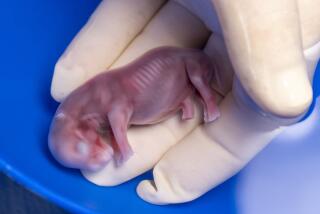Dragon Gets Better Chance at Motherhood
- Share via
An unusual outpatient surgery was performed Monday by San Diego Zoo veterinarians on the last Komodo dragon in the United States in a novel effort to make her fertile and produce more members of the endangered species.
The Komodo, which is the largest lizard in the world, had an experimental device implanted that scientists hope will enable her to ovulate. If it is successful, she will then be impregnated with semen from a male Komodo that died in January at the zoo. Zoo officials, aware that the male was in feeble condition, preserved some of the animal’s semen by freezing it in liquid nitrogen. During their 10 years together, the female had never allowed a mating.
The result, if all goes well, could be as many as 30 baby Komodo dragons and the first successful captive breeding of the species outside its native Indonesia. About 7,000 of the creatures remain on only four islands, including those of Komodo and Flores, in the Lesser Sunda Archipelago.
An intelligent but fierce-looking animal, the Komodo can grow to a length of eight feet and has been known to eat humans occasionally, after charging them at remarkably high speeds for such a large lizard.
Komodos were first discovered by Western zoologists in 1912 and have always been rare in captivity because they require special enclosures kept around 100 degrees year-round and covered like a greenhouse in order to let in the ultraviolet wavelengths that they require from the sun.
Dr. John A. Phillips, San Diego Zoo physiologist who heads the reproduction experiment, already has used similar implants with green iguanas from Central America and other endangered reptiles to try to produce more in captivity so that zoos do not take them from nature and instead begin to replenish threatened wild populations.
The 30-minute surgical procedure by zoo veterinarian Phil Ensley Monday involved insertion of an intravenous-type tube under the Komodo’s skin along its back. The tube is connected to a collapsible bag filled with a hormone inside a small experimental device--about the thickness of a stack of four quarters--which is attached to the animal’s hide with surgical threads and tape.
The experimental device, donated by IVAC Corp. of San Diego, contains a tiny battery that will pump an initial low dose of hormone from the bag through the tube into the Komodo over a two-week period. The bag will then be refilled at a higher dose to maximize the possibility of ovulation. IVAC donated the device as part of an ongoing research effort to eventually develop a device for human use.
“We’re hoping to accomplish this within 28 days, but you have to realize that no one has ever done this with a Komodo dragon before,” said Phillips, who calls his 55-pound charge “Sweetheart.”
The Komodo was given local anesthesia for the procedure. An unsuccessful attempt earlier this year to get the dragon to ovulate involved placing a capsule containing the hormone inside its skin. Pressure from the reptile’s body fluids then pushed against the pump and released the hormonal fluid.
That surgery involved general anesthesia, which is always a large risk to animals. Another advantage of the latest effort is that the level of hormone being introduced can be better monitored because the bag is on the outside of the animal.
“This surgery was a piece of cake,” Phillips said. “She felt nothing more than a needle prick.” Three hospital keepers held the reptile down during the operation. “She’s pretty old (an estimated 18 years) and doesn’t fight that much.”
Phillips said the important thing about the technique is its applicability to a variety of animals.
“When you don’t have animals that readily reproduce in captivity and are down to their last gasp (in nature), we can then be able to stimulate females and have them lay eggs,” said Phillips, whose work is funded through the zoo by the Kaiser Development Corp. of Carlsbad. Phillips said the island habitats of the huge lizard are so limited that a major fire or other massive destruction could eliminate the animals completely.
The Komodo, if successfully impregnated, will carry eggs inside her body for about 60 days and then lay them. They will incubate 60 to 90 days before hatching, Phillips said.
“The Komodo lays the eggs in a nest and then leaves them,” he said. “She doesn’t hang around to watch them hatch.”
More to Read
Sign up for Essential California
The most important California stories and recommendations in your inbox every morning.
You may occasionally receive promotional content from the Los Angeles Times.









